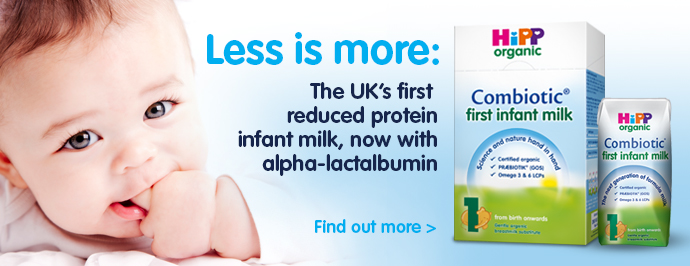Your cart is empty
Differences Among the HiPP Stages

First Infant is HiPP’s primary best-seller, suitable from birth onward up until the age of 1. It is closest in consistency to breastmilk, which is why it remains parents’ first choice. However, there are some other options to consider, depending on the age of your baby and on feeding interval frequencies.
HiPP’s Hungry infant formula is also a milk suitable from birth onward. It differs from First Infant in its whey/caesin ratio. Hungry Infant uses more of the milk’s caesin (a protein) to keep children satisfied. Some parents, especially of infant little boys, will find formula feeding working much better on Hungry Infant–but it has also been the case for girls as well. Hungry Infant can be a great substitute for many babies for their night time and pre-bed feedings, when your little one may need a slower digestion of the milk to keep him sleeping just a bit longer. Hungry Infant can also be used up until the age of 1. In consistency, it will mix a bit thicker than First Infant, so ensure you thoroughly shake the bottle. Many people will ask why HiPP in general seems harder to mix and sticks to the walls of the bottles. This is in fact because HiPP milks contain no artificial emulsifiers.
Please remember that Hungry Infant is not a substitution for First Infant unless your infant is remaining unsatisfied after feedings. Some infants have highly efficient digestive systems that develop earlier and Hungry can be suitable for them. If you want to try Hungry Infant for your baby, start slowly with only a few feedings first. Hungry Infant is not necessarily suitable for all infants.
Follow On Milk is only suitable when your baby is at least 6 months old. Why? There is one important reason to remain on Hungry or First before the age of 6 months, and that is for the inclusion of DHA into the milk formulations. HiPP agrees with the scientific evidence that suggests DHA/ARA is important for early infant brain and eye development. When your baby is exclusively feeding on formula, these compounds cannot be found anywhere else in the diet. When your little one begins eating, these can be obtained from foods. Additionally, the studies show that the inclusion of DHA is far less critical after the 4th month of life.
Follow On Milk contains added iron, which may be useful for your baby if you are unsure of their weaning diet. Once again, you can also derive benefit from using Follow On just for night time or early morning feedings. HiPP’s infant milks are completely compatible with each other and so if your baby likes First Infant, but you want the benefit of a fuller tummy or added iron, you can consider substituting only certain feedings with the other stages.
Many parents are delighted to see the pediatrician at the age of 1 and finally be done with formula. However, more often than not, the transition to whole milk isn’t necessarily uneventful. Remember that even at 1 year old, your baby’s gastrointestinal system is still developing. Many infants will experience mild to severe constipation when transitioning to whole milk, with their parents try to track down the “cause” and drive to the market to find prune juice (extremely high in sugar to use regularly). Often it is simply a transitional issue–although it can last many months. In these cases, HiPP Stage 3 Growing Up milk is good to have in the house. The prebiotic fibres of the milk, even for a few feedings a day or when needed, can do wonders to alleviate constipation as your baby grows into drinking whole milk; no need to add sugary fruit juice to your child’s routine. Combiotic Growing Up milk also contains nutrients beyond what you will find in whole milk alone, and so this may be suitable when you are again unsure your baby is getting what she needs from her food diet.
More questions? Feel free to email us!


Hello,
What is the difference between Infants First and Bio Combiotik?
I purchased Bio Combiotik thinking it was a good supplement to breastfeeding. But after reading your website, I think I may have purchased the wrong one. What do you suggest? She’s a breastfed baby with a very sensitive belly.
Thank you,
Cappy
First Infant is our British version of the formula. It contains no added starches and is the most popular version of HiPP formula. Bio Combiotik PRE is the HiPP German version of the formula which contains the L Fermentum healthy bacteria. Both formulas contain the prebiotic fibres that will help with your baby’s digestion.